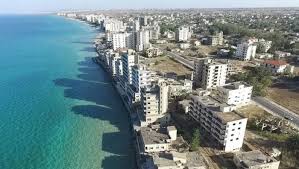Inside Varosha, The Abandoned Resort in Cyprus.

Nestled on the eastern coast of Cyprus lies Varosha, an eerily silent testament to a bygone era of glamour and geopolitical upheaval. This once-thriving resort town, part of the Famagusta district, has stood abandoned for nearly half a century, encapsulating a poignant chapter in the island's tumultuous history. To the discerning eye, Varosha is more than just an empty shell; it is a symbol of the enduring complexities between the Greek Cypriot community and Turkey.
The Rise of Varosha
In the years preceding its abandonment, Varosha was a dazzling jewel in the Mediterranean crown. The town's golden beaches and azure waters drew an elite crowd, earning it the moniker of the "French Riviera of Cyprus." The resort's heyday was marked by opulent hotels, chic boutiques, and an effervescent nightlife that attracted the world's rich and famous. Among its notable visitors were Hollywood legends such as Elizabeth Taylor and Richard Burton, who found solace in its luxurious confines away from the prying eyes of the public. Brigitte Bardot, another illustrious visitor, would stroll along its sun-kissed promenades, adding a touch of cinematic allure to the town's vibrant atmosphere.
The Greek Cypriot Community and the Turkish Invasion
The Greek Cypriot community, who predominantly inhabited Varosha, were part of a larger narrative entwined with Cyprus's colonial past and its struggle for independence. Cyprus, historically under British rule, achieved independence in 1960. However, the island was soon embroiled in intercommunal strife between its Greek and Turkish Cypriot populations.
In July 1974, a coup d'état orchestrated by the Greek military junta aimed to annex Cyprus to Greece. This move precipitated a swift and severe response from Turkey, which cited its right to intervene under the Treaty of Guarantee. Turkish forces invaded the northern part of Cyprus, culminating in the occupation of approximately 37% of the island. Varosha, situated close to the dividing line, fell within the territory occupied by Turkish forces.
Abandonment and the Passage of Time
As Turkish forces advanced, the inhabitants of Varosha fled, leaving behind a town abruptly frozen in time. Hotels still stocked with linens, shops brimming with goods, and homes filled with personal belongings were left to the mercy of nature and the elements. The UN Security Council passed Resolution 550 in 1984, which stipulated that Varosha should be administered by the United Nations and that it could only be resettled by its original inhabitants. Despite this, the town has remained under Turkish military control, effectively barring any resettlement or redevelopment efforts.
For decades, Varosha has stood as a ghost town, its once-bustling streets now overgrown with foliage and its buildings succumbing to decay. The silence of Varosha is a stark contrast to its former vibrancy, serving as a haunting reminder of the island's divided past.
Contemporary Reflections
In recent years, there have been murmurs of potential reopening and redevelopment, particularly following the partial reopening of certain areas in 2020 by Turkish and Northern Cypriot authorities. This move, however, has been met with considerable controversy and has further complicated the intricate geopolitics of the region.
For the Greek Cypriot community, Varosha remains a potent symbol of loss and displacement. The prospect of its reopening raises questions about property rights, historical justice, and the feasibility of reconciliation in a land scarred by division.









Comments